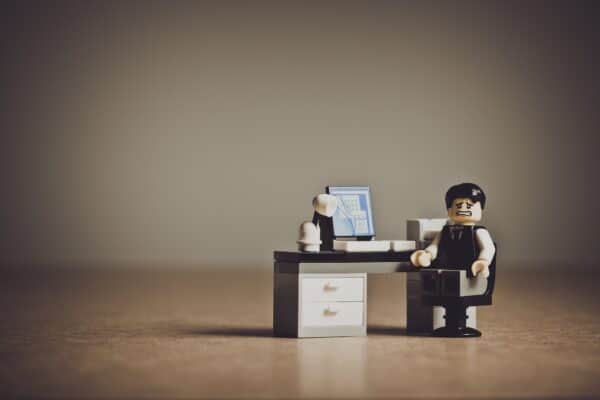New technology has completely transformed the workplace over the past few decades and new tools to improve our performance and efficiency are being developed at an ever increasing speed. We are now surrounded by productivity tools and are more connected than we have ever been before. However, there are downsides to this. With communication tools and platforms now meaning that most office workers can easily login from wherever they are, it’s becoming increasingly difficult to completely switch off when the working day is done. You might find yourself replying to emails just before going to bed or even doing a quick task or two when you’re supposed to be on holiday.
According to the Health and Safety Executive (HSE), 600,000 people suffered with work related stress, depression or anxiety over a 12 month period in 2018/19, mainly caused by an excessive workload. In fact, the study showed that stress, depression or anxiety accounted for 44% of all health-related ill health cases and for 54% of all working days lost due to ill health.
And with tech and digital start-ups and agencies particularly prone to high workloads and an “always on” work mentality, it is these sectors that can be particularly prone to workplace stress.
According to a separate study, 1 million workers never take a lunch break, which when viewed together with the previous study points to a picture of employees struggling to keep up with the demands of the workplace.
These problems have been exacerbated in recent months by the rapid switch to homeworking that many of us have been forced to make due to the Covid-19 pandemic. Without setting strict boundaries between home and work, it becomes nearly impossible to switch off and take effective breaks.
So what can be done to reduce the risk of stress for your workforce and help them create a healthy working environment, whether in the office or at home?
Communication
If most of your working day is spent in front of a computer, you probably know what it’s like to be drowning in all sorts of different communication tools. On top of emails, phone calls, Slack messages, Google Hangouts and social media channels, we’re also making Zoom calls or Google Meet calls part of our day-to-day methods of communications. Simply keeping up with each and every one of these can add unnecessary stress to your working day and it’s easy to forget that sometimes the best form of communication is a good old fashioned face-to-face meeting.
Many workers also have access to their work via their phones. This can easily lead to bad habits such as checking up on work during time off. Seeing an email ping in with another task while you’re outside of working hours can interrupt valuable time spent focusing on your personal life. Discourage staff from this sort of behaviour and suggest that they turn off their notifications out of work hours at the very least.
It might be time to simplify your communications, pairing it down to the most effective channels and creating a space for employees to air their grievances and highlight areas they think could be improved. Even if they are working from home, they should be given the chance to speak to managers and peers on a face-to-face basis regularly. This will create a more harmonious working environment and foster positive interactions.
With more of our communications moving online, it’s also important not to let these interactions become too artificial. Positive communications with other people can help relieve stress by releasing oxytocin. However, if there is too much pressure surrounding a meeting or presentation, this can go the other way and result in stress and anxiety. Emotional intelligence is key here. Ensure that your management team has the training and ability to spot danger signals from their team members and help them make meaningful connections with them on an individual level.
Company Culture
It’s something that is trumpeted by most companies when on the hunt for new recruits, especially in the marketing and creative sectors, but creating a workplace that people look forward to going to in the morning really is crucial for staff wellbeing. Instead of just using it as a recruitment tool, look at how you can inject activities such as summer barbeques and regular socials into the workplace, improving team relationships and giving people the opportunity to let off some steam.
Fostering a company culture where staff feel safe and supported is much more likely to lead to open discourse about what is and isn’t working for your employees. It’s important that they feel there are channels available for them to communicate their problems and anxieties about their work and that the company will do what it can to help them.
The mental health charity, Mind, conducted research which revealed that one in five have taken a day off sick because of stress. However, tellingly, 90% of those gave their work a different reason for their absence. While the stigma surrounding mental health is not as bad as it once was, it certainly hasn’t gone away and businesses need to do more to show their staff that support is available.
Streamline your digital systems
Your digital systems should help your workers perform their tasks more efficiently and easily, they shouldn’t complicate things. Take stock of the programmes you are paying for and think about what is really necessary. Do you use multiple tools for time tracking or task management for example? Would it be easier if your sales and marketing teams were both using the same project management software? Are these complicated systems creating additional hoops for your staff to jump through and resulting in unnecessary confusion and stress?
The best way to find out whether your current system is creating problems, is to simply ask your workers what is and isn’t working for them. You may find that they are having to switch between multiple programmes, recording the same things in several places so that everyone across different teams is up to date. Perhaps your current system is overly complicated, requiring staff to input or record data that isn’t being used.
This is more important than ever, with fewer face-to-face meetings it can be more difficult to ensure that everyone working on a project is on the same page. Misunderstandings and miscommunications can be very stressful, especially when you’re working on a project that has a tight deadline. By simplifying your digital processes and systems, you will be able to spot anomalies quickly and easily while making things a little easier for your staff.
Flexible Working
It’s important to recognise the distinction between flexible working and remote working. While many of us might be working remotely, particularly at the moment, not all of us will have flexible working opportunities to help us adapt to our new situations. Even before the beginning of this tumultuous year, flexible working was a perk being increasingly sought after by top candidates. Work isn’t the only stressful aspect of our busy modern lives and the ability to adapt your work life to meet the needs of your personal life can be crucial for reducing stress in all areas.
While there are many benefits to flexible working, it should be carefully managed as there is the risk that the ‘always on’ mentality can be made worse, especially when workers are working flexibly from home. Without the commute to give your brain the opportunity to process the day’s work and switch into ‘home-mode’, the lines can begin to blur. Without a sufficient break, you won’t arrive back at your desk fresh and ready to go. Instead, you won’t have processed things properly and it can be difficult to make progress, especially if your work involves decision making or creative elements.
Encourage good physical health
When you’re stressed, the body releases cortisol into your bloodstream. While low levels of cortisol are crucial for our health, when we constantly have high levels of the hormone rushing through our bodies you may begin to feel the unpleasant effects of chronic stress. This can be anything from fatigue, headaches and irritability through to weight gain, intestinal problems, and anxiety and depression.
The best way to get rid of this excess cortisol is by sweating, so physical exercise can be key to maintaining good mental health when it comes to stress. Providing your staff with gym memberships or access to exercise classes could add a bit more physical movement into their routines. The good news is that exercise not only works to relieve stress, but it also helps us develop resilience against future stress.
Other factors to consider are a healthy diet and sleep. Even little things like offering fruit in the workplace can make a difference. If you provide your staff with lunch, take a look at the menu and see if fried foods can be replaced with more veg and meals rich in brain-boosting Omega 3.
The short term effects of sleep deprivation can have a serious impact on the ability of your staff to do their jobs to the best of their ability. They may struggle to focus, absorb information or come up with new ideas. However, the long term effects can have serious health implications, such as the development of dementia or Alzheimer’s. Eight hours of sleep every night is the key to a healthy brain. Make sure you’re not championing long working hours late into the night and instead encourage a healthy work/life balance that will be better for you and your workforce in the long run.
Workplace stress is something that affects hundreds of thousands of people in the UK alone and resulted in the loss of 12.8 million working days over a 12 month period in 2018/19 according to a Labour Force Survey. However, with the right processes in place, the risk for your current workers can be reduced and you can create a working atmosphere that is highly sought after by candidates. You’ll improve your staff retention rate and start attracting some of the top talent to join your workforce.









